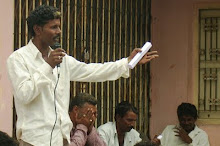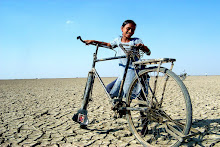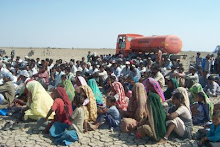The Hindu: National: Tuesday,
February 28, 2017.
 |
| An estimated 200,000 people work barefoot in extreme hardship, exposed to a relentless sun and a host of occupational dangers. (Below, left to right) Dhirubhai flattens the salt pans, a woman holds up the salt she has gathered, and Dhirubhai’s family prepares a meal. | Photo Credit: AFP |
Under a
searing sun, the Agariyas continue to make salt in the Little Rann of Kutch
just as their ancestors have done down the ages
A pair of
black gum boots stands in the corner of Dhirubhai’s temporary shack, his home
for eight months in the Little Rann of Kutch. The shack, built entirely of jute
bags and plastic sheets and propped up by bamboo poles, houses nine members of
his family. It is shaded a little by a babul tree from which hangs a rope
swing.
Adjacent to
the shack stretch the salt pans, beyond which lie miles and miles of barren,
saline, cracked mudflats. These mudflats are intermittently broken by more salt
pans, each with a solitary shack under a lone tree.
I am in the
Dhrangadhra salt zone of the Wild Ass Sanctuary inside Little Rann, which has
five other concentrated salt zones: Kharaghoda, Halvad, Santalpur, Adesar and
Malia. Scattered in these zones are 8,000 to 10,000 families of Agariyas or
salt farmers (‘agar’ is a salt farm). The majority are Hindus, belonging to the
Chunvaliya Koli community while the Miyana and Sandhi are Muslim. They are a
Denotified Tribe, united by their shared occupation, their culture, folk songs
and the hardships of salt farming.
As we sit on
the string cots outside the shack, sipping black tea milk is unavailable here Dhirubhai
and his wife Liliben introduce us to their family. They are dressed like
city-dwellers, the women in sarees and salwar kameez and the men in shirts and
trousers. The older son Vikram is married with three young children. Their
daughters Bhavna and Aarti have been able to attend school up to Class VIII,
even though most Agariyas are illiterate.
Cuts like
salt
As we talk,
my eyes keep drifting back to their bare feet speckled with salt granules
sticking to the chapped skin. Dhirubhai explains that their feet are
perpetually exposed to the highly-saturated brine in the salt pans. “A salt
worker’s hands and feet stiffen and at times water oozes out of our legs,” says
Dhirubhai. All the work is done barefoot that’s the indigenous way salt has
been made for centuries. “The gum boots can be used only when the salt crystals
are hardened. They were gifted by an NGO and spared my feet from cuts and
bruises while levelling the salt pan and shaving and cutting the salt crystals.
This has to be done every day under the scorching sun, and when the salt
hardens like marble, our feet are prone to blisters,” says Dhirubhai.
The older
generations of Agariyas didn’t have this accessory. A popular story goes around
in the Rann that after an Agariya’s death, their stiffened legs do not burn in
the funeral pyre and have to be buried separately. Today, life looks a little
more promising. “The Gujarat government is distributing safety kits with gum
boots, caps, dark glasses and hand gloves,” says Harinesh Pandya, an activist
with Agariya Heet Rakshak Manch in Ahmedabad. Schools, student hostels, mobile
health vans and drinking water are made available to them.
But these
efforts are miniscule. The Little Rann is vast and the salt pans are so spread
out that commuting takes a lot of time. “We receive 1,000 litres of water every
15 days,” says Bhavna. This scarce amount is just enough for drinking and
cooking for her family of nine. Obviously, hygiene and sanitation are
compromised. “We go every alternate day to Navagaon village, some 8 km away, to
bathe.”
The sun and
salt also take a toll on their health. The searing blaze of the sun reflected
by the salt pans causes early cataract and skin problems. When a group of
Bengaluru school children visited here, accompanied by Chirag Munjani, founder
of a responsible tourism initiative called Rural Pleasure, they carried with
them sunglasses and winter cream, among other things. “Most Agariyas suffer
from malnutrition, as they subsist on millets and garlic chutney, which is
their staple diet,” says Munjani. Bhavna describes a typical day. They start at
5 a.m. with black tea and bajra rotlo (pearl millet flatbread). After work in
the salt pans, they have an early lunch at 11 a.m. consisting of khichdi,
buttermilk and sometimes potato or brinjal curry. After a break, they head back
to the pans and work till till 6 p.m. Later in the evening, a cup of black tea
is followed by dinner at 7 p.m., which consists of bajra rotlo, chilli-garlic
chutney and white jaggery.
I am invited
into their kitchen and given lessons in making bajra rotlo amid much giggling.
This breaks the ice. “I like the silence and solitude here more than the four
months we spend in the village,” says Bhavna. She sighs about her marriage in
August, which will take her to an agricultural village. Her father has been
desperately seeking a groom for Aarti as well, so that both sisters might be
married in a single ceremony, an expensive affair that could cost as much as Rs.50,000.
Business
is bad
Dhirubhai is
a worried man the price of salt this season is a measly 20 paise per kilo as
fixed by his salt trader. The price varies every year between 18 paise to 28
paise depending on the quality of salt and the market demand. “They have been
dealing with this uncertainty for generations,” says Chirag.
“The Agariyas
are forced to make an advance trading of salt before the start of a fresh
season each year. They migrate in September to Little Rann of Kutch and return
to the villages by April-May. Every month, they take dhiraan or credit from
traders for food, fuel and daily expenses,” says Pandya. With no access to
formal credit, support prices or insurance, the Agariyas are at the mercy of
the salt traders.
Last year,
Dhirubhai incurred losses. The price fixed was Rs.215 per tonne and he produced
800 tonnes of salt, so he got Rs.1,72,000, while his expenses were Rs.1,87,400.
He could not make more salt because he was short of ground water. Dhirubhai’s
biggest expense Rs.77,400 was on the nine barrels of diesel he needed to pump
brine from the well. This cost him more than food for the eight months.
Electricity he gets from a generator that also powers the TV, their only
entertainment.
Seasoned
in brine
“This season
looks bleak too; the price of diesel has escalated,” he says. “It will only be
in Janmashtami that I will know if I will make a profit or loss.” Janmashtami
is the biggest festival of the Agariyas. The accounts are settled after the
salt production cycle with chhelo chukavo, the final payment after deducting
all credit.
Work starts
just after the monsoon, when the Agariyas take their few possessions on camel
carts or chhakdas and migrate to the Little Rann to lay out the salt pans. The
important tools are dantaala and faantiya (fourteen-and seven-toothed rakes)
and pavdo, pavdi, kodali (types of spades) to dig a new well or repair an old
one. The depth depends on the availability of brine.
In
Dhirubhai’s salt pans, the diesel pumps roar as the brine gushes from the pipe
into flat square salt pans called gamda (condensers). The brine passes through
several condensers and is allowed to concentrate through a natural process of
evaporation. The concentrated brine is fed into larger salt pans called crystallisers.
“It is very important that these are levelled well, that they have a slight
slope for the brine to flow, and that the bed is hard and impervious,” says
Dhirubhai. For this, a salt farmer rhythmically and softly tamps down every
inch of the crystalliser with his feet in a process called pagli paadwani.
“Otherwise, soil can mix with salt while raking,” explains Vikram.
I roll up my
trousers and get into the salt pan with Dhirubhai and his children. It is hard
work. Within a few hours my feet are itching with the clinging salt particles
and the drying mud is stretching my skin.
The Agariyas
continue work well into summer when the temperature soars above 50 degree
centigrade. The continuous raking and scraping has to be done when the layer of
salt crystals reaches a thickness of seven to nine inches. Just before the
dust-laden winds called udaan (and intense vaavar) begin in summer, the salt
crop is harvested. Salt is taken by trucks to the periphery of the Little Rann
to open storage sites called ganjaa. From here, it will be taken to market by
truck or train.
“Salt farming
in most of Little Rann is a dying industry,” says Manish Shah, a salt trader
from Dhrangadhra, who has suffered heavy losses over the past three years and
has quit salt trading. “Diversification from ‘vadagaru’ salt (larger crystals)
to ‘karkach’ salt (fine-grained) and a shift from traditional to scientific
methods of salt farming is required for its survival,” says Bharat C. Raval,
president of the Indian Salt Manufacturers Association in Ahmedabad.
The Agariyas
and activists are also demanding Forest Rights Act that will assure them
traditional user rights for salt farming. “They have no farm land and no other
skills. Salt farming is their sole livelihood,” says Devjibhai Dhamecha, a
naturalist who hails from a salt family. “And there is absolutely no threat to
wildlife by the Agariyas. In fact, the population of endangered wild asses has
increased from 320 to 5,000 in just 50 years,” he adds.
As the fading
sun casts an orange glow, Dhirubhai shows me the place where the railway lines
used to be before Independence just next to their ancestral salt pans. It was
salt that triggered Gandhi’s Dandi March, setting the course of the freedom
struggle. As I leave the Little Rann, I wonder if this community will be able
to chart a new course for its ancient way of life.
(The
writer is a freelance journalist and travel writer who searches for positive
stories across the country.)



















.jpg)
.jpg)
.jpg)
.jpg)













No comments:
Post a Comment